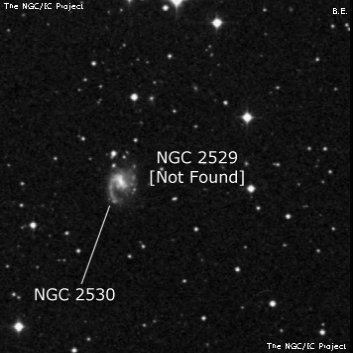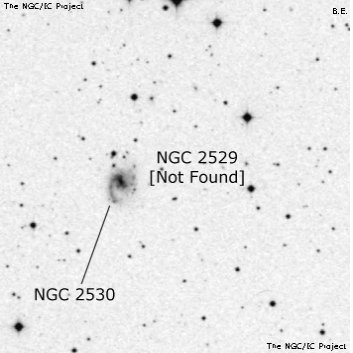=====
NGC 2529, 30, and 31. Herschel did indeed discover N2530, and this is the
name that, as Steve Gottlieb suggests, should be used for the galaxy. The
other two objects were found by Bigourdan very close to N2530. Though he
examined the field four times, he saw his two new objects only once. On that
one night, he estimated positions with respect to N2530: N2529 is 1' distant
at position angle 220 deg, and N2531 is 1' distant at PA = 150 deg. There is
nothing in either position on the PSS. He also measured a thirteenth
magnitude star the same distance away from N2530 on two nights; it is just
where he saw it in
= 15 deg. On the second night, Bigourdan claimed to
see stellar objects at the very limit of visibility where he placed N2529 and
N2531 earlier, but he did not attempt to measure them. It's clear to me that
the two do not exist, probably being those faint illusions that we all see now
and then when we get tired or try too hard to push the limits of our optics.
May 2008. Jeffrey Corder has suggested that the southern arm of NGC 2530
might be NGC 2531. I think this is unlikely for several reasons. First, the
arm's surface brightness is very low. It also does not extend as far to the
south as the star at = 15 deg is to the north, yet Bigourdan estimated
the distances to be equal. Third, on one night, he called NGC 2530 itself
"extremely faint, only suspected," and did not mention any other objects near
it. Fourth, while there is a faint knot at the end of the arm, its position
angle with respect to the galaxy's nucleus is closer to 170 degrees rather
than the 150 that Bigordan estimated. Finally, Bigourdan claimed to have seen
two stellar objects south of the nucleus -- the arm would be only one of these
were it one of Bigourdan's objects.
While I think these are sufficient to cast doubt on Jeff's suggestion, I have
not seen the field with a telescope of the size that Bigourdan used. It is
just possible that he could have seen the galaxy's arm with his long-focus
refractor.



